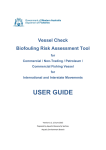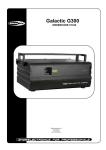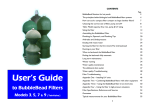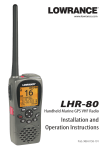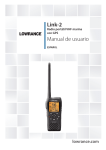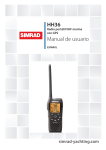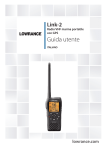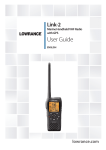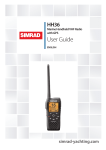Download Whistler GPS100 Owner`s manual
Transcript
GALILEO™ GPS Introduction Introduction If you have any questions concerning the operation of this Whistler product please call: Customer Service 1-800-531-0004 Hours: Monday – Friday 8:00 am to 5:00 pm CT or visit www.whistlergroup.com Please keep the receipt in a safe place. You may register your Galileo™ GPS online at: www.whistlergroup.com. If the unit is returned without a dated store receipt an out of warranty service charge applies. Note: Your warranty period begins at the time of purchase. The warranty is validated only by a copy of the original store receipt. Now is the time to record the serial number of the unit (located inside the battery compartment), in the space provided in the warranty section of the manual. 1 Enjoy GALILEO™ GPS Dear Whistler Owner, Thank you for purchasing the Whistler Galileo™ GPS. Please take the time to read the owner’s manual in order to understand and maximize use of the operating features. There is no better way to experience what’s near you or how to get there, than by using a Whistler Galileo™ Handheld GPS. Both the Galileo™ GPS and Galileo™ Whistler Map™ software were designed for ease of use to make your purchase and experience a pleasant one. This manual and our Whistler Customer Service are here to assist you. For more general GPS information or frequently asked questions, please see our FAQ page at www.whistlergroup.com. Enjoy your GALILEO™ Handheld GPS Before using the Galileo™ GPS for the first time make sure that you read the important safety and use information in the sections that follow. Enjoy the Galileo™ GPS. Please drive safely. Sincerely, The Whistler Group, Inc. 2 GALILEO™ GPS Standard Packaging Includes Standard Packaging This manual applies to the Whistler Galileo™ GPS and the Galileo Elite™ GPS.* Standard Packaging Includes: Galileo Elite™ GPS • 1 Galileo™ GPS unit with base maps of the continental United States • 2 Whistler Map™ CD’s with detailed maps of the continental United States • 32 MB Standard Type II Flash Card • PC Interface Cable with USB Connection • Quick Start-Up Guide & Owner’s Manual • Whistler Map™ User’s Guide Galileo™ GPS: • 1 Galileo™ GPS unit with base maps of the continental United States • 1 Quick Start-Up Guide & Owner’s Manual *Some parts of this manual apply to the Galileo™ GPS ONLY with the optional Galileo™ GPS Accessory Upgrade Pack. Galileo™ Accessory Upgrade Pack: • 2 Whistler Map™ CD’s with detailed maps of the continental United States • 32 MB Standard Type II Flash Card • PC Interface Cable with USB Connection • Whistler Map™ User’s Guide 3 Safety Information GALILEO™ GPS Important Safety Information WARNING: It is the user’s responsibility to use this product prudently and maintain safe-driving practices at all times. This GPS should be used only by someone able to clearly understand the instructions and able to operate the controls. For proper safety we recommend that a passenger operate the Galileo™. However, in cases where you are alone, it is recommended that you pull over to make any adjustments to the Galileo™. It is also important to make sure that the unit is secure, does not block the driver’s field of vision, and will not become a hazard in case of an accident. Do not mount or place the Galileo™ on an air bag equipped steering wheel or passenger area. In case of an accident this can be deadly. Important Safety Information The Global Positioning System (GPS) is operated by the government of the United States, which is solely responsible for its accuracy and maintenance. The system is subject to changes which could affect the accuracy and performance of all GPS equipment. 4 GALILEO™ GPS GALILEO™ Whistler Map™ Software Software The base map and detailed mapping software are provided by Navtech Technologies Corporation. The base map and optional detailed mapping software are as accurate and detailed as possible. Whenever maps are digitized, there is still a possibility that some inaccurate or incomplete data can be found. It is because of these inaccuracies that the Galileo™ is a travel aid and is not intended for precise measurement in navigation or aircraft use. Galileo™ / Whistler Map™ Software Use Terms Copyright laws protect the Galileo’s operating system and internal mapping software. The optional Whistler Map™ Software CD contains detailed mapping software (Standard on Galileo Elite™) which is copyrighted. Please review carefully the software agreement information enclosed in the Whistler Map™ User’s Guide. Note: By opening the CD package you accept the terms and conditions listed in the agreement. Once opened, the CD package cannot be returned to the place of purchase. ©2002 Navigation Technologies. All rights reserved. 5 FCC Compliance GALILEO™ GPS This device complies with Part 15 of the FCC Rules. Operation is subject to the following two conditions: (1) This device may not cause harmful interference, and (2) this device must accept any interference received, including interference that may cause undesired operation. FCC Compliance This equipment has been tested and found to comply with the limits for a Class B digital device, pursuant to part 15 of the FCC Rules. These limits are designed to provide reasonable protection against harmful interference in a residential installation. This equipment generates, uses and can radiate radio frequency energy and, if not installed and used in accordance with the instructions, may cause harmful interference to radio communications. However, there is no guarantee that interference will not occur in a particular installation. If this equipment does cause harmful interference to radio or television reception, which can be determined by turning the equipment off and on, the user is encouraged to try to correct the interference by one or more of the following measures: • Reorient or relocate the receiving antenna. • Increase the separation between the equipment and receiver. Changes and modifications not expressly approved by the Whistler Group, Inc., may void the warranty. Repairs should be made only by an authorized Whistler Repair Center. 6 GALILEO™ GPS Table of Contents 7 Table of Contents Features ...........................................................................................................................8 External Functions ..................................................................................................9 Button Functions .....................................................................................................9 Battery Installation................................................................................................10 Compact Flash Card (CF).....................................................................................11 First Time Usage..........................................................................................................12 Getting Started.......................................................................................................12 Simulation Mode ........................................................................................................13 Adjusting Contrast......................................................................................................13 Night Viewing .......................................................................................................13 Obtaining Satellite Signals.......................................................................................13 Cold Start ......................................................................................................................14 Finding Your Way - Main Navigational Pages......................................................15 Map Page ......................................................................................................................16 Display Information...................................................................................................17 Hide or View Icons ...............................................................................................17 Points of Interests..................................................................................................18 Measuring Distances ............................................................................................18 Shortcut .........................................................................................................................19 System Settings ...........................................................................................................20 Change a Setting ...................................................................................................20 Waypoints .....................................................................................................................21 Set a Waypoint.......................................................................................................21 Trip Page .......................................................................................................................22 Set the Correct Time..............................................................................................22 Reset Values ...........................................................................................................22 Change the Track or Speed / Distance Measurements...................................22 Compass Page ..............................................................................................................23 Change a Route to Travel to ................................................................................23 Locating Services, Cities, Roads, POI’s, etc.......................................................23 Find a City ....................................................................................................................24 Set Location............................................................................................................24 Search Settings ............................................................................................................25 Find the Nearest Road..........................................................................................25 Change the Nearest Search Setting ....................................................................25 Main Menu Items........................................................................................................26 Waypoints...............................................................................................................26 Enter New Waypoint Coordinates .....................................................................26 Routes ............................................................................................................................27 Enter a Route .........................................................................................................27 Turn a Route On or Off ........................................................................................28 Insert a New Waypoint into a Route..................................................................28 Delete All or One Waypoint from a Route........................................................28 Track Logs.....................................................................................................................29 Start or Stop a Track Log......................................................................................30 Clear a Track Log ..................................................................................................30 Save a Track Log....................................................................................................30 Change Track Log Information...........................................................................31 Turn On / Off Track Log Display from the Map Page ...................................31 Delete a Track Log ................................................................................................32 Change Datum.............................................................................................................32 Loading..........................................................................................................................33 NMEA Output .............................................................................................................33 Troubleshooting ..........................................................................................................34 Galileo™ GPS Specifications...................................................................................36 Settings..........................................................................................................................37 Warranty Information ...........................................................................................38-40 Features GALILEO™ GPS The Whistler Galileo™ is designed to be user friendly and easy to operate. The Galileo™ GPS features include, but are not limited to the following: Features • Storage for 500 waypoints with names. • A track log (bread crumbs) with storage capability of five tracks and 2500 points each. • Seven (4 main) navigational screens including satellite, map (zoom in and zoom out capabilities), compass, trip, goto navigation, track logs, and shortcut screens. • Route building capabilities, with storage for 20 routes with 30 waypoints each. • 16 MB of built in memory storing base map of the continental United States, waypoints and routes. • Expandability with additional memory and detailed Whistler Map™ software (with optional Galileo™ GPS Accessory Upgrade Pack). 8 GALILEO™ GPS Functions External Functions Functions 1. External power jack provides connection for the optional 12 to 3 volt DC power cord. See 9-A. 2. Data jack provides connection for the optional USB PC interface cable. 3. Battery & Compact Flash Card compartment uses 2 AA batteries and optional type II compact flash card. 4. External Antenna provides connection for an active external GPS antenna. Requires a male MCX connector. 9-A 9-B 9 Button Functions (See 9-B and 9-C) 1. Display Screen provides map and “points of interest” information. 2. Page/Escape (ESC) Button selects different navigation screens or exits current menu. 3. Power (PWR) Button press and hold turns unit on/off. Turns backlighting on/off. 4. Zoom In (IN +) Button lowers the viewing area. Pressing for 2 seconds turns on/off map mode and map scale. 5. Zoom Out (OUT - ) Button increases the viewing area. Pressing for 2 seconds hides or displays interstates. 6. Menu Button opens option selection screen. Press this button twice enters the main menu. 7. OK Button in menu mode, selects a menu item. In the Map Page, press and hold for 2 seconds creates a waypoint. 8. Direction Button allows movement through menu items. While on the map page, press and hold this button in any direction for access to the arrow. The arrow can be moved either up/down or left/right. It can be used to display info about POI’s or highways. 9-C Battery Installation GALILEO™ GPS Battery Installation This unit requires 2 AA batteries (not included). 1. Remove the battery compartment cover by using your thumb to grab the release tab. See 10-A. 2. Remove the insert that is in the battery compartment and discard. 3. Insert the optional Compact Flash memory card into slot. Note: The unit will operate without this card. See page 11 for Compact Flash card information. 4. Observing correct polarity (+) and (-), insert batteries as shown. 5. Reinstall battery compartment cover. For best performance from alkaline batteries we recommend using the highest capacity type available as recommended for digital cameras and portable CD players. Battery Installation 10-A Note: Make sure that alkaline batteries are removed from the unit when using the optional cigarette lighter adapter cord. If the batteries are not removed, damage to the batteries and/or the unit will result. If using rechargeable AA batteries, for longer life select the highest capacity available. Ni-MH rechargeable batteries are recommended. Common rechargeable batteries have a power rating of 1700mA or higher. Note: DO NOT mix battery types as this can damage the batteries. Lithium batteries are recommended for use in cold temperatures. Remove the batteries when the Galileo™ will not be used for an extended period of time. Damage caused by leaky or improperly charged batteries (For example; Alkaline batteries in unit while using the optional power cord) is not covered under warranty. Check with the battery manufacturer about their specific product warranty and disposal recommendations. 10 GALILEO™ GPS Compact Flash Card Compact Flash Card (CF) Compact Flash Card The Galileo™ uses standard Type II Compact Flash (CF) Memory Cards. These cards can be added to the Galileo™ GPS receivers through the battery compartment. CF cards come in many configurations up to 1024 MB. The addition of a CF card to the unit allows data to be uploaded/download to/from the Whistler Map™ Software CD (provided with the Galileo™ Accessory Upgrade Pack and Galileo Elite™). Important: Make sure that the CF card you purchased (other than from Whistler) has the CF and FCC logo’s clearly visible. Add or Remove the Compact Flash Card Add or Remove the CF card: 1. Press and hold the power button to turn the unit off. 2. Remove the battery door. 3. Remove both of the AA batteries. 4. To remove the CF card, gently pull the CF card slightly towards the top of the unit. Carefully continue to slide the CF card out of the channel it’s in. Tilt the Galileo™ to help remove the CF card. 5. To install the CF card, hold it such that the tiny holes are at one end facing the bottom of the unit and the lip is on the top. Place the CF card in the channel provided in the battery compartment. Note: CF card can only go in one way. Carefully push the CF card towards the bottom of the unit until you feel it lock into place. Do not force the CF card. Forcing the CF card could cause damage to the card and/or the unit. 6. Reinstall the batteries into the battery compartment. Be sure to observe the proper polarity. 7. Replace the battery compartment door. 8. Press and hold the Power (PWR) button to turn on the Galileo™. 11 First Time Usage GALILEO™ GPS The Galileo™ has a protective plastic layer over the display screen. Remove this layer before use. You are now ready to travel with your Galileo™! Using Your Galileo™ For The First Time It is best to be outside and have a clear sky above you to allow the Galileo™ to obtain better reception of the satellites. Clear sky means no trees, bridges, overhangs, carports etc. Cloudy skies are ok. Holding the unit at 45 degrees from horizontal is optimum and a natural position for using the unit. See 12-A. Having an open area around you is important for first time use, any time that the unit has not been used for an extended period of time, and when the Cold Start function is used. See Cold Start section on page 15 for more information. Getting Started With the batteries properly installed, press and hold the Power button until the greeting screen is displayed then release the Power button. The greeting screen momentarily displays the mapping and Operating System (OS) release versions [See 12-B] then displays the warning page [See 12-C]. While the greeting screen is displayed, write down the OS and Map release information in your manual for future reference. This information can also be found on the “Main Menu” under the “About” selection. This information is necessary should you inquire about the Galileo’s operation or order new software. Using Your GALILEO™ For The First Time 12-A Getting Started 12-B This warning screen is to let you know that the GPS unit does have limitations and that they affect accuracy. Press the PAGE/ESC button to acknowledge the warning message and continue. If the PAGE/ESC button is not pressed within 60 seconds the unit will turn itself off. See 12-D. 12-C 12-D 12 GALILEO™ GPS Simulation Mode Simulation Mode Simulation Mode To get a feel for the many useful features and also conserve battery life, switch the unit to simulation mode. Simulation mode allows the unit to function without acquiring satellites. This gives you time to learn many of Galileo’s useful features. After turning the Galileo™ on, the screen will display the Satellite page, trying to obtain a satellite. See 14-B. Press the menu button, press Stop Navigation, then OK. This will allow the unit to function without searching for satellites. Note: The Galileo’s Memory Feature saves your setting when the unit is turned off. If the Galileo™ was set in Simulation Mode before being turned off, is will be in the same mode next time the unit is turned on. Simulation mode is also used to look up map information, set up waypoints and routes before, during or after a trip. While in this mode, the unit is not looking for satellite signals, which conserves battery power. Once at a location, you can locate area attractions and other Points Of Interests (POI), using the Search Object menu selection. This capability is only with the Whistler Map™ detailed mapping software available with the Galileo™ GPS Accessory Pack or with the Galileo Elite™. See page 26 for description of menu items. Since the Galileo™ knows your last position before entering Simulation Mode, it uses this information when referencing distance to services or POI’s. Note: Under SIMULATION mode, you cannot use National Marine Electronics Association (NMEA) 0183 output. See NMEA section on page 33. 13 Adjusting Contrast GALILEO™ GPS Adjusting Contrast If lighting conditions make it hard to view the display screen, the backlight can be adjusted for optimum viewing. Adjusting Contrast 1. Press the PAGE/ESC Button until the satellite page is displayed. 2. Move the Direction Button either to the left or right and the contrast display setting will be shown. Move to the left or right to adjust the lightness/darkness of the screen. See 14-A. 3. After adjustment, press the OK Button or the PAGE/ESC button to exit. Extensive use of the backlight will reduce battery life. Night Viewing 14-A Press the PWR Button to turn on backlighting. The amount of time the backlighting is on can be adjusted from the Settings Menu. See System Settings Section on page 20. Obtaining Satellite Signals The Satellite page shows the GPS satellites that are available and their signal strength. Once a satellite is acquired and fixed, the signal bar for each satellite will turn dark. Signal strength of the satellite signals will be shown by length of signal bar. The longer the signal bar displayed, the stronger the signal. This page also displays which satellites are locked on, your location coordinates, background lighting on/off, DOP number (the lower the number the better the satellite signal), and battery status. See 14-B. At least three satellites are needed for the Galileo™ to operate properly. When the unit is searching for satellites, it may take several minutes to acquire three or more strong signals from the orbiting satellites. When you use the Galileo™ for the first time, perform a Cold Start (See page 15) or when you are over 500 miles from where the Galileo™ GPS was last turned on, the unit may require longer (5 to 10 minutes) than normal time to acquire the necessary three or more satellites. After the satellites are acquired and fixed, your position is identified and the display changes to the map page. Satellite Signals 14-B 14 GALILEO™ GPS Cold Start Cold Start Cold Start Performing the Cold Start function decreases the time it takes to get a satellite lock. Cold Start means that the Galileo™ has no reference to use as a guide to tell it what satellites should be overhead. Without a reference, the Galileo™ will search the sky trying to find any satellite that may be overhead. This can increase the time it takes to get its first satellite lock. (Up to 10 minutes in severe conditions.) Under normal operating conditions, the last satellite lock computed before the unit was turned off, is stored into memory and will be used as the reference the next time the unit is turned on. Also, if you travel for more than 500 miles with the Galileo™ turned off, it will still have the reference point, but it may be too inaccurate to be useful. In this case you may want to perform a Cold Start. Main Navigational Pages 15-A Finding Your Way - Main Navigational Pages Galileo™ provides a total of four screens to provide services, show you points of interest (POI) and to help you keep track of your travels. The following is a brief description of the main navigational pages. By pressing the PAGE/ESC Button, each of these pages will be displayed. Main Navigational Pages 1. Satellite Page 2. Map Page 3. Trip Page 4. Compass Page 15-B 15 Satellite Page Map Page Trip Page Compass Page The Galileo™ has a horizontal or vertical screen viewing option. If you would like to change the orientation of the display, simply press and hold the Page Button. See 15-A and 15-B. Map Page GALILEO™ GPS Map Page Map Page The Map Page displays your current position, coordinates and zoom in/out level in miles. The Galileo™ will show major highways, cities and coastlines. More detailed maps of cities, streets, and POI’s will be displayed with the optional (standard on Galileo Elite™ model) Whistler Map™ Software CD (also available in the Galileo™ GPS Accessory Pack). The pointer represents your location and direction on the map. See 16-A. When the pointer is solid, this indicates a good signal. When the pointer is clear, this indicates a weak signal, no signal or the unit’s in simulation mode. See 16-B. The circle surrounding the pointer represents the accuracy of your location. Move the Direction Button in any one of the four directions and a curser like arrow is displayed. Detailed information is shown when this arrow is pointed to a road or POI on the map. See 16-C. Moving this arrow to any edge of the display moves the map so you can see what is around you. 16-A 16-B In the lower right corner of the map screen is a viewing information center. This center displays the zoom level of the map (.1 to 200 miles), viewing area location vs. ma (a “You are here” view), and POI’s longitude and latitude. To turn on/off the Information center press and hold the Zoom In (+) button for 2 seconds. 16-C Map Scale On Map Scale Off 16 GALILEO™ GPS Display Information Display Information Display Information The POI’s shown on the Map Page are represented by Icons. These Icons can be turned on or off along with roads and Interstates to allow for easier viewing of the map. To see what the Icons mean, or to customize your screen by turning all or some of them on or off, follow the steps below. Hide or View Icons Display Icons Hide or View Icons Display - Hide Points 1. From the Map Page, press the MENU Button. 2. With the Direction Button, move to “Display Icons” option and press the OK Button. 3. To understand the meaning of the icons, move the Direction Button to the “?” box and press the OK Button. 4. Move the Direction Button to an Icon and press the OK Button to hide that Icon. 5. Repeat step 4 for additional Icons. 6. To hide a group of Icons press the Menu Button – Move the Direction Button to the “Hide All”, “Hide Points” or “Hide Roads” and press Direction Button. 7. To show a group Icons press the Menu Button -- Move the Direction Button to the “Show All”, “Show Points” or “Show Roads” and press Direction Button. Note: Steps 6 and 7 may have a mix of “Hide” and “Show” options displayed depending on the options you chose. 8. When finished, either move the Direction Button to the “X” and press the OK Button or simply press the PAGE/ESC button to save changes and exit. Note: On the Display Icons Page, the “Check” mark icon means accept, the “X” means escape. Quick tip! If you only want to hide or view the roads simply press and hold the Zoom Out Button. This could be beneficial when hiking and using the track logs (bread crumb) feature. Display - Hide Roads 17 Points of Interests GALILEO™ GPS Points Of Interests Information (Only available with the Whistler Map™ software provided with the Galileo Elite™ or with the Galileo™ GPS Accessory Pack) Points of Interests 1. Move Direction Button to a POI or road on the map. 2. Press MENU Button. 3. Select “Show MapInfo” and press the OK Button. An Info screen will display the POI’s name, county, country, distance from last known GPS location and (if available) its phone number. See 18-A. Note: The arrow must be on a road or POI, otherwise the “Show MapInfo” option will be grayed out and not available. 18-A Measuring Distances While displaying the Map Page you can measure the mileage between points or multiple points. Up to five “point to point” measurements can be made. The mileage for point to point is shown on the screen. 18-B To Measure Distances 1. From the Map Page, press the Menu Button. 2. With the Direction Button move to “Show Dist On” option and press the OK Button. See 18-B. 3. Move the Direction Button to where you want to start measuring from. Press the OK Button again “0 ft” will be displayed. See 18-C. 4. Move the Direction Button to where you want to start measuring to. As you move the Direction Button the mileage (or Kilometers – if selected) is shown along with a dotted line. See 18-D. 5. To measure another point, simply press the OK Button and the total mileage for the first point is displayed and a new measurement starts. See 18-D. 18-C 18-D 18 GALILEO™ GPS Shortcut GoTo Navigation Shortcut Shortcut/GoTo Navigation This type of navigation is “line-of-sight” or as the old phrase goes “as the crow flies”, from one point to another. The Map Page will display dotted lines from where you are to the destination you have set. Note: The Shortcut option does not work if Routes is turned on because routes are also displayed by dotted lines. See Routes section on pages 27 and 28 for more information. The Compass Page (see page 23) will display the compass heading to your destination that you programmed in. Setup A Shortcut Setup a Shortcut 1. From the Map Page, press the MENU Button. 2. Select either “Search Object” or “Nearest Search” and press the OK Button. 3. Select your GoTo area (Region) & press the OK Button. 4. Select your GoTo destination type and press the OK Button. 5. Select your GoTo destination and press the OK Button. Info for that selection will be shown. 6. Press the OK Button. The map page will now show your destination. 7. Press the Menu Button again and select “Shortcut On”. 8. Press the OK Button to toggle the Map Page back to your current position. Search Object Near Search Select Region Select City Info Select City On Map 19 Search Object Shortcut On Select City Shortcut On GALILEO™ GPS System Settings System Settings Some common settings that can be accessed from any page are; Backlighting, Navigation Mode, NMEA Output, Map Direction and Units (Miles vs. Kilometers) See 20-A. Most of the settings affect the Map Page. System Settings Backlight allows you to change the time the background lighting remains on. Navigation Mode allows you to select Normal, Saving or Simulate mode. Saving mode allows the unit to still search for satellites but not as often, thus saving battery life. This setting is not recommended for difficult terrain or in city areas where satellite reception may be weak. 20-A NMEA Output allows the Galileo™ to communicate to NMEA 0183 ready devices. See page 33 for NMEA information. Map Direction switches the map page orientation from North being the direction heading or Track. Track relates to either a shortcut (GoTo) or waypoint location. When Track is selected a small Icon in the top left of the screen points in the direction of North. Units switch between US and Metric measurements. Change a Setting 1. Press the MENU Button. 2. Select “Settings”. 3. Move the Direction Button to the setting you wish to change and press the OK Button. 4. Move the Direction Button to the desired selection and press the OK Button. 5. Select another setting or select to exit and save changed settings. Set Page Settings Set Page Light Set Page Navigation Set Page Measurements Set Page Directions Set Page Units Change A Setting 20 GALILEO™ GPS Marking a Waypoint 21-A Set a Waypoint 21-B 21 Waypoints Waypoints A waypoint is a marker, shown on the map, to a location you would like to come back to another time. This waypoint could be a POI, intersection or a favorite fishing spot. Up to 500 waypoints can be stored in the Galileo™. Waypoints can also be grouped/recalled by name, i.e., FISH1 or CAMP2. Up to eight characters can be used for a name. The Galileo™ groups waypoints by the first character in the name. If that character is blank then it groups by the next character i.e., “_FISH_ _ _” will be grouped different than “FISH_ _ _ _” or “_ _ _ _ FISH” or even “_ _FISH_ _”. Set a Waypoint 1. Move the Direction Button to the location you want to come back to. 2. Press and hold the OK Button until the waypoint screen is shown. See 21-A. A default waypoint name is automatically given to this location. 3. To keep the default name simply press the OK Button or move the selection to the “Check” box and press the OK button. The waypoint will be saved with the default name and displayed on the map page. See 21-B. 4. To change the default name or add a comment simply move the Direction Button to that field and press the OK Button. 5. With the field highlighted press the OK Button. Move the Direction Button up or down to select a different letter, number, or character. 6. Move the Direction Button right or left to move to the next area. 7. Press the OK Button to enter the changes for this field. 8. Move the Direction Button to the next field or simply move to the “Check” box to save changes and go back to the Map page. Note: Do not change the information in the other two fields! See page 26 for more information. 9. To have the waypoint not to be shown on the Map Page, simply uncheck the box under the “Active” field. Trip Page / Set Time GALILEO™ GPS Trip Page Trip Page The Trip Page displays many data fields with information as you travel. This information displayed includes compass heading, speed, track, trip time, altitude, average speed, coordinates, date and time information. Set the Correct Time: 1. From the Trip Page, press the MENU Button. 2. With the Direction Button, move to “Change Time” option and press OK. See 22-A. 3. Move the Direction Button to the “hour” location and press OK. 4. Select the correct time difference for your location by moving the Direction Button up or down. 5. Press the OK Button when correct adjustment is made. Eastern 5 hours Central 6 hours Mountain 7 hours Pacific 8 hours (Add 1 hour for non-daylight savings time) 6. Move the Direction Button to the “Check” box to save changes and exit. See 22-B. 22-A 22-B Reset Values After a trip is completed or if you are reversing your direction, you can reset the Trip Page to start again. 1. From the Trip Page, press the MENU button. 2. Select “Reset Value” and press the OK Button. See 22-C. Change the Track or Speed / Distance Measurements (US vs. Metric) 22-C 1. From the Trip Page, press the MENU Button. 2. Select “Settings” and press the OK Button. 3. Move the Direction Button to “Units” and press the OK Button. 4. Select either “KM/KMH” or “Mi/MPH”. 5. Select “OK” to exit and save changed settings. Note: This setting change is for all pages not just for the Trip page. Trip Page 22 GALILEO™ GPS Compass Page Compass Page Compass Page The Compass Page shows your current direction, next waypoint in a route, distance and time to next waypoint, and final destination. The small arrow above the compass represents your direction. The large arrow in the compass points in the direction of a waypoint or shortcut (GoTo) you have entered. To enter a shortcut, see the Shortcut/GoTo Navigation section on page 19. 23-A NOTE: When no Routes are saved, or if the shortcut option is turned off, the large arrow will not be displayed. All the “TO” fields will display “0”. See 23-A and 23-B. See pages 27 and 28 for Route entering. Change a Route to Travel to 1. From the Compass Page, press the Menu Button. 2. Select “Change Next WP” and press OK. See 23-C. 3. Select new waypoint and press OK. See 23-D. 4. New route is displayed. See 23-E. Note: If no routes are entered you cannot change this setting. 23-B 23-C 23-D 23 Locating Services, Cities, Roads, POI’s etc. The base Galileo™ map OS (Operating System) lists major cities, roads and interstates. The Galileo™ Elite, and the Galileo™ GPS Accessory Upgrade Pack, which both includes the optional Whistler Map™ Software CD providing detailed maps, allows for more information on restaurants, hotels and other POI’s. The same steps to find a city can be used to find other POI’s. Simply follow the same procedure below but substitute the different type (service) needed. Note: If there is no information shown for the type you have selected, either that information is not in memory, (either in the detailed map [CF card] or base map) or there is no POI in that area. 23-E Find A City GALILEO™ GPS Find A City Find A City 1. Start from the Map Page [See 24-A] & press the MENU Button. 2. Move the Direction Button to the Search Object option and press the OK Button. 3. Move the Direction Button to the State desired and press OK. 4. Move the Direction Button to the City option and press OK. 5. Move the Direction Button to the City desired and press OK. When a city is selected a City Info screen will display the city name, county, state, country and distance from last known GPS location in its memory. See 24-B. To have the Map Page show you the selected city, simply press the OK Button. Set Location If the city selected is out of max zoom range and you need information on POI’s in that area, simply use the “Set Location” menu item from the main menu list. The “Set Location” item allows the Galileo™ to think that you are at that location. See 24-C. 24-A 24-B Note: Detailed information is only available with the Whistler Map™ detailed mapping software provided with the Galileo™ GPS Accessory Upgrade Pack and the Galileo Elite™. To find services, cities, POI’s that are close to your GPS location (under five miles), you can select Nearest Search from the menu items on the Map Page. 24-C 24 GALILEO™ GPS Find the Nearest Road Search Settings Find a Nearest Road 1. Start from the Map Page and press the MENU Button. 2. Move the Direction Button to the Nearest Search option and press the OK Button. 3. Move the Direction Button to the Road option and press the OK Button. 4. Move the Direction Button to the Road desired and press the OK Button. The nearest search default setting is 1 mile around you. Five miles is the highest setting. Change the Nearest Search Setting Change the Nearest Search Setting 1. Repeat steps 1 through 3 above. 2. Press the MENU button. The Distance box is highlighted. 3. Press the OK Button. 4. Move the Direction Button to the distance you require then press the OK Button. 5. Move the Direction Button to the Road you are interested in and press the OK Button. Near Search 25 Search Object Search Object Main Menu Items GALILEO™ GPS Main Menu Items Even if you’re not an experienced GPS user, the step-bystep procedures for the main menu items are easy to follow. The main menu consists of the following: Waypoints, Routes, Track Logs, Cold Start (page 15), About, Change Datum, and Loading. Each menu item has its own sub menu items (except About and Cold Start). The main menu can be accessed from any navigation page. Waypoints As discussed in the Map Page section, the Galileo™ can store up to 500 waypoints. Waypoints can be entered in two ways: Main Menu Items 26-A Method 1 1. While on the Map Page, move the pointer to a POI or a road, etc. 2. Simply press and hold the OK Button until the waypoint screen is shown. See 26-C. Method 2 1. Select “Waypoints” from the main menu. See 26-A. This brings up the waypoint selection screen. 2. Press the Menu Button and select “New”. The waypoint screen will be displayed. See 26-B. 26-B Note: Method 1 is the easiest way to enter a waypoint. Method 2, which can be used from any navigation page, is the best way if you have the longitude and latitude of a known location. Enter New Waypoint Coordinates (Longitude / Latitude) 1. Move the Direction Button to highlight the navigation field, press the OK Button 2. The first character is highlighted. Move the Direction Button up or down to select a different letter or number. 3. Move the Direction Button right or left to move to the next area. 4. Continue above procedure for all coordinates. 5. Press the OK Button to enter the changes for this field. 6. Move the Direction Button to the “Check” box to save changes and go back to the waypoint selection page. 26-C Naming and grouping waypoints is discussed on page 21. An * next to a waypoint indicates that it is also saved as part of a Route. 26 GALILEO™ GPS Routes Routes Routes The Galileo™ can store 20 routes with up to 30 waypoints each. Routes can be followed either from the Map Page or on the Compass Page. Note: The routes screen will not have any routes listed if this is the first time using this screen. See 27-A. 27-A Important: Waypoints must be programmed before making routes. Remember, the Galileo™ does not provide turn-by-turn navigation; it’s strictly “as the bird flies.” An “*” next to a route name indicates that the route’s navigation is turned on. The Routes menu consists of: New, Edit, Delete, Delete All, Set Navi and Cancel Navi (Navi = Navigation). Note: Only a total of 500 waypoints can be used for routes. 27-B 27-C 27-D 27 Enter a Route: 1. With the Direction Button, select “Routes” from the Main Menu, and press the OK Button. The routes screen will be displayed. See 27-A. If routes were previously entered it will show the names of these routes and the waypoints for each route listed. See 27-B. 2. Press Menu and select New by pressing the OK Button. This is the only option if no routes have been entered. 3. A default route name “R001” is displayed. The next route name will be R002 etc. You can change the name or add a comment at any time. See Waypoint section for editing the name and comment fields. 4. Press Menu and select “Add WP” by pressing the OK Button. This is the only option if no waypoints have been entered. 5. Move the Direction Button until all waypoints are highlighted and press the OK Button. See 27-D. 6. Select first waypoint to go to and press the OK Button. Number “1” will be displayed next to the waypoint selected. 7. Repeat step 6 for the remaining waypoints for the route. See 27-C. 8. Press the PAGE/ESC Button, then select the “Check” box and press the OK Button. If finished, press the OK Button again. This returns you to the routes screen. 9. Press the PAGE/ESC Button to exit the routes name screen. Routes GALILEO™ GPS Turn a Route On or Off 1. Select “Routes” from the main menu. 2. Select a route and press the Menu Button. If only one route is listed, it is automatically selected. 3. Select “Set Navi” to begin or “Cancel Navi” to stop. An “*” next to a route name indicates that that route’s navigation is turned on. See 27-B. Turn A Route On or Off Insert a New Waypoint into a Route Insert A New Waypoint Into A Route Note: Must turn route navigation off before a route can be edited. 1. Select “Routes” from the main menu. 2. Select a route and press the Menu Button. If only one route is listed, it is automatically selected. 3. Select “Edit” and the routes name screen is shown. 4. Select the waypoint field and press the OK Button. 5. Select a waypoint that the new waypoint will be located in front of and press Menu. Note: If the waypoint field remains highlighted the new waypoint is inserted last. 6. Select “Insert WP” and select new waypoint and press the OK Button. 7. Press the OK Button again to highlight the waypoint field and select the “Check” box. 8. Press the PAGE/ESC Button to exit the routes name screen. Delete All or One Waypoint from a Route 1. Select “Routes” from the main menu. 2. Select a route and press the Menu Button. 3. Select “Edit”. Note: Must turn route navigation off to delete waypoints. 4. Highlight the waypoint field and press the OK Button 5. Select waypoint to delete and press Menu. 6. Select “Delete WP”. An “Are you sure?” message screen is displayed. Press the OK Button to delete. 7. Press Menu to add or delete a waypoint or press the OK Button and highlight the “Check” box to exit edit page. Delete All Or One Waypoint From A Route 28 GALILEO™ GPS Track Logs Track Logs Track Logs Think of track logs as simply “bread crumbs” that leave a trail behind so that you can find your way back. The track log is shown on the Map page by dots along your route. See 29-A. The Galileo™ can store up to five track logs with each track recording up to 2500 points, which is 12,500 points total for the five tracks. Points mean a longitude and latitude recorded for a location or “point” determined by the distance and/or time field setting in the recording page. See 29-B. The Track Log menu consists of: Clear Tracking, Save Tracking, Delete, Show On (or Show Off), Edit & Information, Distance, and Recording Mode. Note: Navigation must be turned on and have a satellite lock to record or clear Track logs. There are two different methods of recording track logs, Fill or Wrap. See 29-C. When “Fill” is selected the track log will record points until the track log memory is full. When full, a message is displayed to either save the track log or clear it. When “Wrap” is selected and the track log memory is reaching full capacity, it will overwrite or record over the beginning track log. 29-A 29 29-B 29-C Track Logs GALILEO™ GPS Start or Stop a Track Log 1. Select “Track Logs” from main menu. 2. Select the tracking field (default is “Off”) and press the OK Button. 3. Choose either “Fill” “Wrap” or “Off” and press the OK Button. If “Off” is selected simply select the “Check” box to exit. 4. Press Menu and select “Recording Mode”. Note: If no tracks have been saved this is the only option. The recording page will be displayed. 5. Select either “Distance Interval” or “Time Interval” (between points) needed and press the OK Button. Note: When the field displays “- - - - - -“, that field is ignored. If both fields display “- - - - - -“ the unit defaults to 1 second time interval for recording points. 6. Select interval and press the OK Button. Highlight the “Check” box to exit recording set up page. Start or Stop A Track Log The Galileo™ will begin recording once it determines your location. Note: When recording, this track log will not be displayed on the track log page until it is saved. When a trip is finished you have two options for the track log that was recorded, clear it or save it. Clear a Track Log 1. Select “Track Logs” from main menu. 2. Press Menu and select “Clear Tracking”. Save a Track Log 1. Select “Track Logs” from main menu. 2. Press Menu and select “Save Tracking”. Clear A Track Log Save A Track Log When a track log is saved, the Galileo™ automatically provides a default name (date of recording) for the track log. To edit the default name and to turn on/off the track log display on the Map Page, see the next two procedures. 30 GALILEO™ GPS Change Track Log Information Track Logs Change Track Log Information 1. Select “Track Logs” from the main menu. 2. Select the track log field, press the OK Button. 3. Select the track log to edit and press Menu Button. 4. Select “Edit & Info”. 5. Move the Direction Button to highlight the track name field, press the OK Button. 6. The first character is highlighted. Move the Direction Button up or down to select a different letter or number. 7. Move the Direction Button right or left to move to the next area. 8. Press the Direction Button to enter the changes for this field. 9. Repeat step 5 to change the Comment field. 10.Move the Direction Button to the “Check” box to save changes and go back to the track log selection page. The Track Log or “bread crumbs” displayed on the Map Page can be turned on/off. If there are different track logs in memory, another track log can be selected to show on the Map Page. Turn On / Off Track Log Display from the Map Page Turn On/Off Track Log Display from the Map Page 1. Select “Track Logs” from the main menu. 2. Select the track log field, press the OK Button. 3. Select a track log and press Menu Button. 4. Select either “Show Off” (to remove track log from the map page) or “Show On”. 5. Press the Direction Button twice to highlight the track log field. 6. Move the Direction Button to the “Check” box to save changes and go back to the previous navigation page. TIP: If a track log has a dotted box around it – simply press Menu and select either “Show Off” or “Show On”. The dotted box will go around the last track log used or edited. When a trip is through and then saved, the track log is no longer needed, it can be removed from memory. 31 Track Logs / Datum GALILEO™ GPS Delete A Track Log 1. Select “Track Logs” from the main menu. 2. Select the track log field, press the OK Button. To delete all track logs skip next step. 3. Select a track log and press Menu Button. 4. Select “Delete”. Change Datum This section is used for navigation on water. For traveling on roadways this function is not necessary. A datum is a mathematical model of the Earth. Map makers may use a different model to chart their maps, so position coordinates will differ from one datum to another. Lines of latitude and longitude on a map or chart are referenced to a specific map datum. Every chart has a map datum reference. The datum for the map you are using can be found in the legend of the map. Delete A Track Log Change Datum If you are comparing the GPS coordinates to a chart or other reference, the map datum in the Galileo™ should be selected to the same map datum that is listed as the datum used to generate the chart or other reference. If the datum setting on the Galileo™ is different than the chart used, your coarse could very well be off. This can be dangerous. The common datum used is WGS84 and this is Galileo’s default datum and one of 221 datums in memory. To change the datum 1. Select “Datum” from the main menu. 2. Select the datum that matches the chart you are using. Tip: When “Datum” is selected, press Menu to choose the new datum by the beginning letter. 32 GALILEO™ GPS Loading Loading / NMEA Output Loading This menu item allows detailed maps, waypoints, and routes to be downloaded into the Galileo™. Saved waypoints, track logs, and routes from the Galileo™ can also be uploaded into a PC. Detailed instructions are included with the Whistler Map™ Software CD (included with Galileo Elite™ model and the Galileo™ GPS Accessory Upgrade Pack). NMEA Output NMEA Output What is NMEA? National Marine Electronics Association. A professional organization that defines and maintains the standard serial format used by marine electronic navigation equipment and computer interfaces. Additional information on NMEA can be found at on the internet at www.nmea.org. This output is used to relay GPS information to NMEA 0183 ready devices. NMEA-0183 v2.20e4800/9600 baud, 8N1. NMEA message: GGA, GSA, GSV, RMC (Standard Output), GLL, and VTG (Optional). Note: NMEA output must be turned off before uploading or downloading any maps, waypoints or routes. NMEA output will not work in simulation mode. The Galileo™ is not compatible with DGPS devices. 33 Troubleshooting GALILEO™ GPS Unit Will Not Turn On Troubleshooting 1. Check to see if batteries are installed correctly. 2. Replace with two new AA alkaline batteries. 3. Need to hold the power button for at least 2 seconds. Unit Will Turn On, Then Turn Itself Off: 1. Batteries may be weak – too weak for the low battery warning to be displayed. Replace with two new AA alkaline batteries. 2. Did not accept warning page, unit timed out and turned off. Takes More Than 10 Minutes To Get A Position Fix: 1. If there are any obstacles nearby or overhead, move to a new location. 2. Make sure that the antenna is pointing up, has a clear view of the sky and is a reasonable distance away from your body. 3. Check Satellite Status screen to see if the receiver is acquiring data. 4. If the receiver still does not get a position fix within 10 minutes, you need to perform a Cold Start procedure. Unit Is Not Leaving “Bread Crumbs” Along My Route 1. Make sure that “Track Logs”, from the main menu, is set to either “Fill” or “Wrap”. Battery Life Seems Shorter Than It Should Be: 1. Make sure that you are using two AA alkaline or high capacity Ni-MH rechargeable batteries. 2. Shorter life span of the batteries can be due to excessive use of the backlight. Turn the backlight off when not needed. 3. In the “Setting” menu, try using the “Saving” option in the “Navigation Mode” selection. 4. Ni-Cd batteries are not recommended. These batteries will not provide enough power long enough to be useful. Replace the Ni-Cd’s with Ni-MH type rechargeable batteries. 34 GALILEO™ GPS Troubleshooting Trouble Shooting Position Coordinates On Your Receiver Do Not Match The Location On Your Chart (map). Make sure that the Galileo™ is set up to use the same datum as your chart. The map datum is generally shown in the map legend. See Change Datum section for instructions on selecting the map datum in your receiver on page 32. Position On Map Is Not Exactly On The Road. It could be caused by distance shifts to the digitized map. Use map information for reference only and do not rely completely on it. Data Was Not Saved Or Was Corrupted. This can be caused because you removed the batteries or removed external power with the Galileo™ turned on. If you do not see your question listed please visit our GPS FAQ page of our website www.whistlergroup.com or call Whistler Customer Service (800) 531-0004 Available Monday through Friday 8am to 5pm CT. The following accessories can be ordered directly from Whistler by calling: Galileo™ GPS Accessories 35 (800) 531-0004 Galileo™ GPS Accessories Item: Price: Dash Pad Cigarette Lighter Adapter Cord 32 MB Standard Type II Compact Flash Card Soft Grey Flannel Carrying Case Black Faux Leather Carrying Case $6.95 $15.95 $24.95 $9.95 $9.95 Specifications GALILEO™ GPS Specifications Specifications Receiver: 12 parallel-channel Physical Dimensions: 5.15” H x 2.45” W x 1.1” D Weight: 7.1 ounces with 2 AA batteries and Compact Flash card installed Power Source: 2 AA alkaline batteries or 3 VDC with optional power cable Battery Life: Up to 12 hours Interface: NMEA 0183 Accuracy Update Rate: 1 second continuous Position: 16.4 ~ 82 feet Velocity: 0.22 MPH / sec Speed Limits: 1152 MPH Altitude: -3280 ~ +59,040 ft Acquisition Times (under optimal conditions) Cold: Approximately 5 minutes Warm: Approximately 40 seconds Hot: Approximately 15 seconds High Contrast LCD with EL Backlit Display Display Size: 2.35”H x 1.55” W Resolution: 100 x 160 dpi Housing: Weatherproof to IPX7 standards (waterproof to one meter for 30 minutes) Temperature Range Operating: -4°F to 158°F (-20°C to 70°C) Storage: -40°F to 185°F to (-40°C to 85°C) 36 GALILEO™ GPS Factory Settings Factory Settings Factory Settings The following features are default settings when Galileo™ is turned on for the first time. GPS Engine: Power savings on Navigation on WGS84 Datum Greenwich Time measure Display: Waypoints and roads only (Internal base map) North Up map orientation Distance measuring off US measurement (miles/MPH) Waypoints: Starts with W001 Routes: Starts with R001 NMEA Output: Turned OFF Track Log: (Bread Crumbs) Turned OFF Recording Mode – Distance: 300 ft, Time: 10 seconds Show tracklogs: OFF (for saved track logs) 37 Warranty Information GALILEO™ GPS Consumer Warranty This Whistler Galileo™ GPS is warranted to the original purchaser for a period of one year from date of original purchase against all defects in materials and workmanship. If the Whistler Galileo™ GPS unit is replaced, it is still warranted ONLY from the date of original purchase, not 1 year from the date of replacement. This limited warranty is void if the unit is abused or modified, if the housing has been removed, or if the serial number is missing. There are no express warranties covering this product other than those set forth in this warranty. All express or implied warranties for this product are limited to one year. Whistler is not liable for damages arising from the use, misuse, or operation of this product. Consumer Warranty Service Under Warranty Service Under Warranty During the warranty period, defective units will be repaired without charge to the purchaser when returned with a dated store receipt will be handled as described in section “Service Out Of Warranty.” Due to the specialized equipment necessary for testing a Whistler Galileo™ GPS, there are no authorized service stations for Whistler Galileo™ GPS other than the Whistler factory. When returning a unit for service under warranty, please follow these instructions: 1. Ship the unit in the original carton or in a suitable sturdy equivalent, fully insured, with return receipt requested to: Whistler Repair Department 1201 North Dixieland Road Rogers, AR 72756 IMPORTANT: Whistler will not assume responsibility for loss or damage incurred in shipping. Therefore, please ship your unit insured with return receipt requested. COD’s will not be accepted! 38 GALILEO™ GPS Service Under Warranty Warranty Information Service Under Warranty (Continued) 2. Include with your unit the following information, clearly printed: ❏ Your Name ❏ Street Address (for shipping via UPS) (NO P.O. Boxes Please) ❏ Daytime Telephone Number ❏ E-Mail Address (if applicable) ❏ A detailed description of the problem (e.g., “Unit does not receive satellite). ❏ A copy of your dated store receipt or bill of sale 3. Be certain your unit is returned with its serial number. For reference, please write your units serial number in the following space: S/N: _________________________________________ OS: __________________________________________ GPS Version: __________________________________ Detail Map Version: ____________________________ Base Map Version: _____________________________ Units without serial numbers are not covered under warranty. IMPORTANT: To validate that your unit is within the warranty period, make sure you keep a copy of your dated store receipt. You may register your warranty online at www.whistlergroup.com. For warranty verification purposes, a copy of your dated store receipt must still accompany any unit sent in for warranty work. 39 Warranty Information GALILEO™ GPS Service Out Of Warranty Units will be repaired at “out of warranty” service rates when: • The unit’s original warranty has expired. • Dated store receipt is not supplied. • The unit has been returned without its serial number. • The unit has been abused, modified, or had its housing removed. Service Out Of Warranty The minimum out of warranty service fee for your Whistler Galileo™ GPS is $95.00 (U.S.). If you require out of warranty service, please return your unit as outlined in the section “Service Under Warranty” along with a certified check or money order for $95.00 (U.S.). Payment may also be made by MasterCard, VISA or American Express; personal checks are not accepted. In the event repairs cannot be covered by the minimum service fee, you will be contacted by a Whistler technical service specialist who will outline options available to you. IMPORTANT: When returning your unit for service, be certain to include a daytime telephone number, and email address (if applicable). 40










































